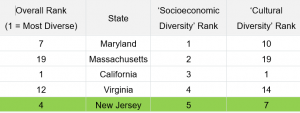This is the first installment of a series of posts devoted to protecting New Jersey’s students from acts of harassment, intimidation, bullying, discrimination, and self-harm.
It’s more than bullying. Protecting students from acts of…
Each morning about 1.8 million New Jersey students (20% of the state’s population) stretch and yawn as the new day’s sun paints a golden glow across the eastern horizon. From the sands of Atlantic City to the hills of Verona and from the historic shores of Delaware in Burlington Township to the Boardwalk in Asbury Park, school doors across New Jersey open wide to welcome students who represent an amalgam of groups. According to the U.S. Census Bureau, New Jersey is the fourth most overall diverse state, the fifth most socioeconomically diverse and seventh-most culturally diverse.
As of 2011, 56.4% of New Jersey’s children under the age of one belonged to racial or ethnic minority groups, meaning that they had at least one parent who was not non-Hispanic white.

New Jersey has the second-largest Jewish population by percentage (after New York); the second-largest Muslim population by percentage (after Michigan); the largest population of Peruvian Americans in the United States; the largest population of Cubans outside of Florida; the third-highest Asian population by percentage; the third-highest Asian Indian population of any state by absolute numbers; the third largest Korean population, with Bergen County home to the highest Korean concentration per capita of any U.S. county (6.9% in 2011); and the fourth largest Filipino population; and the fourth largest Chinese population, per the 2010 U.S. Census.
250,000 adults in New Jersey are LGBT
36% of LGBT adults are raising children
Approximately 20,000 students in New Jersey age 13-18 are LGBT
And as of October 2016, over 216,000 public-school students were enrolled in special education programs.
- Autism – 18,511
- Deaf–blindness – 16
- Emotional Disturbance – 7,718
- Hearing Impairment – 1,479
- Multiple Disabilities – 1,5259
- Intellectual Disability – 5,045
- Other health impairment – 4,5461
- Orthopedic Impairment – 354
- Specific Learning Disability – 75,231
- Speech or Language Impairment – 46,283
- Traumatic Brain Injury – 536
- Visual Impairment – 365
With that said, it is obvious that New Jersey’s public schools are among the most diverse in the nation.
Diversity in public schools is a good thing, right?
The answer to this question is, maybe.
Diversity is a very good thing if the school’s culture embraces, honors, respects, and celebrates its diversity. On the other hand, diversity is a challenge if the school’s culture is to use actual or perceived differences among students to predict their values, choices, preferences, and abilities.
One of Us or One of Them?
If school staff speak in general terms about a group of students and refer to them as “they”, and continue their statement with either:
- they always;
- they never;
- they can’t;
- they won’t;
- they don’t; or
- they will;
then the diversity of that school’s student population is viewed by its staff as a barrier, not a bridge. Fortunately, New Jersey has a comprehensive law that is designed to build bridges for public school students who require assistance overcoming cultural barriers that impede their access to receive a free education as required by the New Jersey State Constitution.
What is the New Jersey Law Against Discrimination?
The New Jersey Law Against Discrimination protects all public-school students who belong to or are perceived to belong to a protected group. In New Jersey, schools are prohibited from discriminating against students based on race, creed, color, national origin, ancestry, nationality, sex, sexual orientation, gender identity or expression, and disability; and requires covered schools to take appropriate action to prevent and remediate discrimination against a student because of his or her actual or perceived race, color, religion, national origin, ancestry, nationality, sex, sexual orientation, gender identity or expression, or disability.
When schools do not take appropriate preventative and remedial action, they may be held responsible for discrimination committed by students, school employees, volunteers, and by those contracted service providers who have significant contact with students. Discrimination is based on a “perceived” protected characteristic when the perpetrator believes that the victim is a member of a Law Against Discrimination-protected group or has a Law Against Discrimination-protected characteristic, even if that belief is wrong.
For example, harassing a heterosexual student using derogatory words or phrases commonly associated with homosexuality may constitute discrimination based on perceived sexual orientation. Similarly, harassing a non-Muslim student using anti-Muslim comments may constitute discrimination based on perceived creed or religion. (NJ Department of Education)
Who enforces the New Jersey Law Against Discrimination?
The Division on Civil Rights (DCR) in the New Jersey Department of Law and Public Safety is the state agency charged with enforcement of the Law Against Discrimination. A student or parent may file a complaint directly with the Superior Court of New Jersey, without first filing with the Division on Civil Rights or the school. So, for school staff, it should be obvious at this point that they are charged with the affirmative responsibility to provide students with the opportunity to receive an education in an environment that is free from discrimination and bias. School staff is dealing with so much more than “just bullying.” They must protect their students from acts of harassment, intimidation, bullying, discrimination. and self-harm.
This is all easier said than done. But not impossible. Every barrier can be spanned by a bridge.
